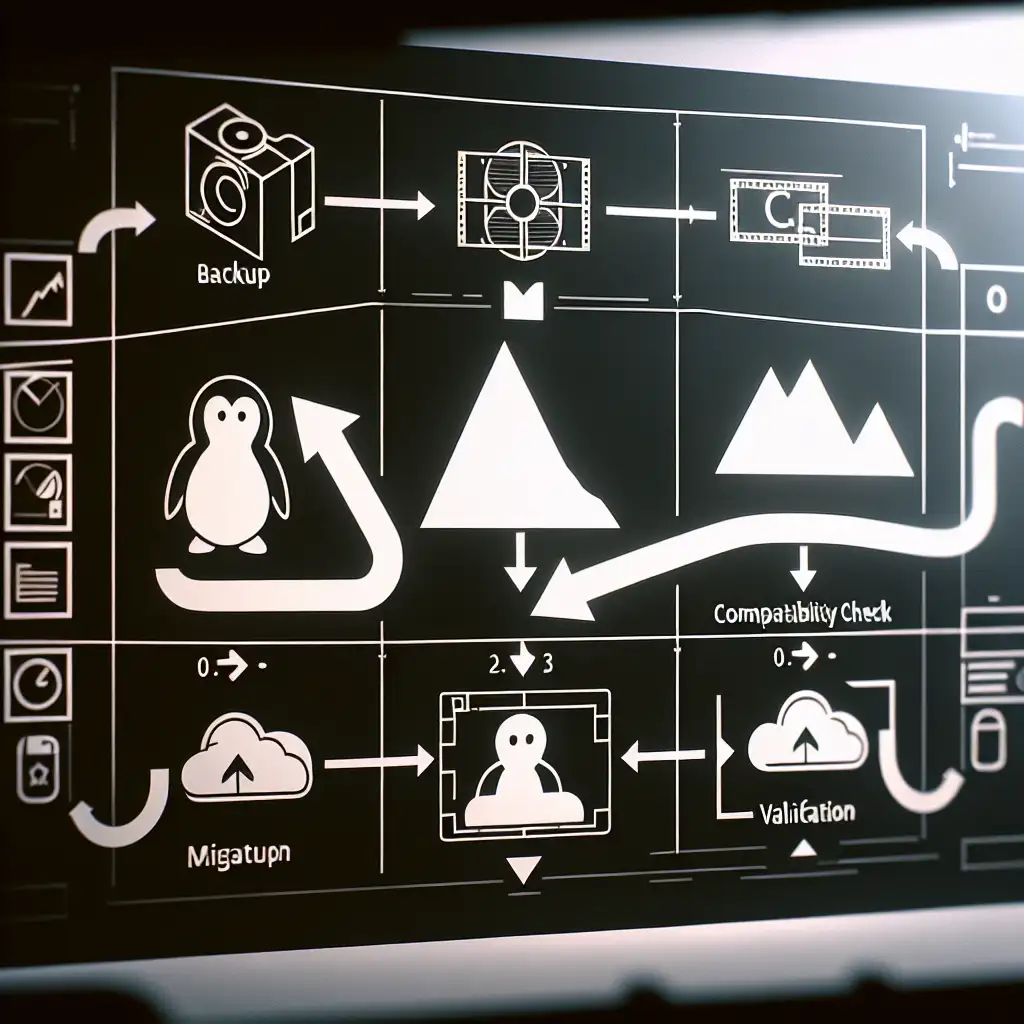Seamless Migration: CentOS 8 to Rocky Linux
CentOS 8 reached end-of-life in December 2021. Continued operation on unsupported infrastructure is a direct risk: no security patches, no bug fixes, and an increasing set of broken dependencies as repositories disappear.
Rocky Linux—community-built, ABI-compatible with RHEL—covers this gap. Direct migration preserves service continuity for production workloads in cloud and on-prem.
Before You Begin
Host migrations seldom go as simply as the tool’s README implies. Start with the non-negotiables:
- Full machine backup: Disk snapshot (
LVMor VM-level) or file-level backup (e.g.,rsync,tar). Snapshots in VMware, AWS, or Proxmox are significantly faster to restore than bare metal. - Root or sudo access: Standard. Some operations will fail quietly if permissions are insufficient.
- Stable connectivity: The migration script pulls packages from Rocky mirrors; latency or dropouts can corrupt transaction state.
- Inventory validation: Capture kernel, installed packages, custom repo state.
cat /etc/os-release # Confirm CentOS Linux 8.x
rpm -qa --qf '%{NAME}\n' > pkgs.txt
dnf repolist > current-repos.txt
uname -r # Kernel version (warn for vendor modules)
Tip: Document the output of these commands. It’s your rollback insurance if post-migration troubleshooting is needed.
1 — Patch and Reboot
No migration should proceed on a partially patched OS. Unapplied updates mean mismatched RPMs and unpredictable failures.
sudo dnf clean all
sudo dnf update -y
sudo reboot
After reboot, confirm clean state:
cat /etc/centos-release
df -hT # Disk space (insufficient space is a common gotcha)
2 — Audit and Disable Non-Base Repositories
Third-party repositories (e.g., Remi, ELRepo, custom in-house) create package conflicts during distro migration. EPEL can be disabled now and re-enabled post-upgrade.
Example audit:
ls /etc/yum.repos.d/
sudo dnf repolist all
Disable all except CentOS base and updates:
sudo dnf config-manager --disable <repo_id>
Store the original repo configuration. Some plugins (e.g., DNF versionlock) may interfere—confirm their state.
3 — Fetch and Prepare the migrate2rocky Tool
Rocky’s migration script, migrate2rocky, handles repo switching, package moves, and system metadata updates with minimal manual intervention. Version as of this writing: migrate2rocky.sh (2023-09-21).
curl -O https://raw.githubusercontent.com/rocky-linux/rocky-tools/main/migrate2rocky/migrate2rocky.sh
chmod +x migrate2rocky.sh
sha256sum migrate2rocky.sh # Always verify hash for supply-chain trust
4 — Perform a Dry Run
Never run migration scripts "blind." The -c flag checks the entire process, highlighting breakpoints:
sudo ./migrate2rocky.sh -c
Look for output lines such as:
[WARN] Ephemeral package conflicts: kernel-modules-extra-nvidia
[INFO] To be replaced: centos-stream-release -> rocky-release
Spot any custom/critical packages (nvidia-dkms, custom OpenSSL)? Investigate before proceeding. Hardware-specific drivers often require a different approach.
5 — Switch to Rocky Linux
Confident in dry-run results? Proceed.
sudo ./migrate2rocky.sh -r
Core actions:
- YUM repo files (
/etc/yum.repos.d/*) are rewritten for Rocky mirrors. - All CentOS branding in
/etcreplaced (e.g.,/etc/centos-release→/etc/rocky-release). - DNF refreshes all RPMs for compatibility.
- System metadata, such as
/etc/os-release, gets updated.
Depending on your package count and I/O, expect 10–40 minutes. Network drop? The script is resilient, but don't interrupt unless absolutely necessary.
Known issue: Service restarts (sshd, firewalld) can transiently drop connections. For remote sessions, favor screen/tmux.
6 — First Boot: Post-Migration Hardening
Immediately after migration:
sudo reboot
cat /etc/os-release
Expected:
NAME="Rocky Linux"
VERSION="8.8 (Green Obsidian)"
ID="rocky"
- Reactivate required repositories one at a time
- Test each with
sudo dnf repolist
- Test each with
- Re-add EPEL
sudo dnf install epel-release -y - Synchronize packages
sudo dnf distro-sync -y - Validate all major services
sudo systemctl status httpd sudo systemctl status mariadb - Examine system logs:
journalctl -p 3 -xb # Show critical errors since boot
Note: SELinux contexts may need relabeling, especially with custom /var or /srv mounts.
7 — Regression and Functionality Testing
Functional validation is mandatory. Don’t assume package migration preserves subtle local changes:
- Spin up test jobs (CI/CD runners, batch workers).
- Check logins via all expected methods (local, SSH key/cert, LDAP).
- Query databases, hit endpoint URLs, monitor for application error logs.
A simple curl http://localhost:80/ isn’t a validation for a multi-service web stack. Use integration tests if available.
Automation: Ansible Example
For estates of more than a handful of hosts, use automation tools. This reduces variance and audit time.
- name: Rocky Linux migration
hosts: centos8fleet
become: yes
tasks:
- name: Download migrate2rocky
get_url:
url: https://raw.githubusercontent.com/rocky-linux/rocky-tools/main/migrate2rocky/migrate2rocky.sh
dest: /usr/local/bin/migrate2rocky.sh
mode: '0755'
- name: Run migrate2rocky
command: /usr/local/bin/migrate2rocky.sh -r
register: migration
- name: Record migration logs
copy:
content: "{{ migration.stdout }}"
dest: "/var/log/migrate2rocky-ansible.log"
Note: For clusters, stagger reboots to avoid downtime.
Troubleshooting Reference
| Symptom | Investigation/Remedy |
|---|---|
GPG key error | Import Rocky GPG manually: rpm --import /etc/pki/rpm-gpg/* |
| Dependency cycle during update | sudo dnf clean all && sudo dnf distro-sync -y |
| Service won’t start | Compare /etc config with backup; check SELinux logs |
| Migration script aborts | Review /var/log/migrate2rocky.log for last completed op |
Atypical edge case (seen once): If migration script hangs on stale NFS mounts, unmount or remount with soft option before retrying.
Conclusion
Production migrations are won or lost in the preparation phase. Trust but verify: always run dry, maintain current and tested backups, and give special consideration to vendor modules or in-house daemons.
Rocky Linux 8.x is a stable drop-in for CentOS 8 hosts—assuming process discipline is followed. Quick-fix “one-liners” often miss lurking configuration drift. If you encounter failures that persist after the above, consider rebuilding from Rocky install media. Sometimes that's cleaner.
Non-obvious tip: On virtual platforms (e.g., VMware, AWS, GCP), snapshot before disabling repos—sometimes, network changes during migration can leave agents or monitoring tools in a broken state before you realize it.
For advanced deployments (complex multi-homed routing, custom security modules), perform staged cutovers and leave sufficient maintenance windows. Consider alternate distros—AlmaLinux, Oracle Linux—if Rocky's cadence ever lags.
Migration isn’t glamorous, but it’s defendable.
